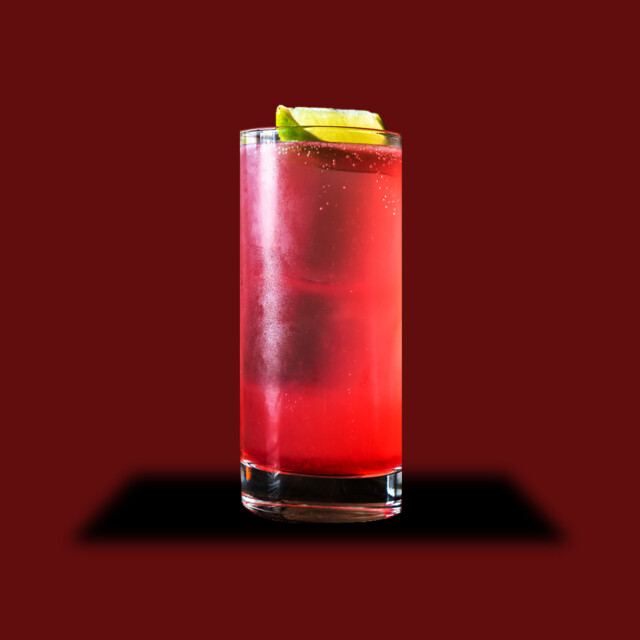There’s a little tradition that has cropped up recently at Sunken Harbor Club, the tropical bar tucked just above the Brooklyn chop house Gage & Tollner. A few times a night you’ll hear a loud cry go up: “El Diablo!” the crowd will shout. They are heralding the arrival of an El Diablo cocktail, an old tequila drink that is on the menu.
That the Sunken Harbor Club bartenders hear this several times a night is just one sign that this previously obscure 1940s cocktail is enjoying a heyday like never before.
“It is one of the few classics that features tequila, and it belongs to the even smaller club of tiki classics that feature the spirit,” says Garret Richard, a bartender at Sunken Harbor Club.
Linden Pride, a founder of the family of Dante bars in New York, has such confidence in the appeal of the El Diablo that he put the cocktail on tap at the newly opened Dante Seaport in lower Manhattan. A typical El Diablo is made of tequila, lime, crème de cassis, and either ginger ale or ginger beer. Dante’s, however, is comprised of tequila, mezcal, crème de cassis, Meletti bitter, chili tincture, and grapefruit soda, making it a sort of cross between an El Diablo and a Paloma.
“El Diablo has been a favorite cocktail of mine since my early bartending days in London,” says Pride, who is originally from Australia. “The tequila with the spice was always such a great, refreshing mix. With the growing popularity of tequila over the last couple of years, we were looking for a long tequila cocktail for summer — with the caveat that it must be on tap.”
The El Diablo is currently on offer at multiple bars across the United States, including: Remedy in Chicago; Soundbar in Lexington, Ky.; At Random in Milwaukee; Dullboy Bar in Jersey City; Kinfolk Lounge & Library in Austin; Radio Bar in Spokane, Wash.; The Bygone in Baltimore; the Tides Beach Club in Kennebunkport, Maine; Public and General in Gainesville, Fla.; and the Regent Cocktail Club in Miami. At Boucherie, the chain of four French restaurants in Manhattan, the drink is listed as Le Diable, and is made with mezcal and grilled grapefruit juice.
When the industry publication Drinks International ran its annual list of the 50 most popular drinks in the world in 2021, the El Diablo was ranked at No. 46, right between the White Lady and the Cosmopolitan. It had not made the list since 2015.
So why is El Diablo back in force? To Pride, the answer is obvious.
“Increased demand for agave spirits, and bartenders looking to classics to mash up,” he says.
Tequila and mezcal have skyrocketed in popularity in recent years. And the number of extant classic cocktails — “classic” in this case just meaning old — that feature either spirit can be counted on one hand. As far as tequila goes, you have the Margarita, of course. The Paloma — more popular in Mexico than the Margarita — has become a staple over the past five years thanks to agave-focused cocktail bartenders. The Tequila Sunrise, popular in the 1970s, still has too tacky a reputation to enjoy a complete comeback. That leaves the El Diablo, which, unlike the Tequila Sunrise, benefits from having almost no reputation whatsoever with the public. The drink is such a blank slate that it almost reads like a new cocktail to most drinkers.
“To me, it’s fascinating,” said Richard, “because it lives in the ecosystem of tequila long drinks. The original Tequila Sunrise, the Mexican Firing Squad, and the El Diablo all have similar DNA. In my opinion, the El Diablo is the final evolution of those ideas.”
The origins of the El Diablo are typically traced back to Trader Vic’s, the mid-century tiki-bar chain founded by Victor Bergeron. The drink appeared in Trader Vic’s cocktail manual in 1946, and Bergeron put a “Mexican El Diablo” on his 1947 cocktail menu. Tiki scholar Jeff Berry speculates that Bergeron was riffing on a similarly structured rum drink called the Diablo. The drink vanished from the Trader Vic’s menu in the 1950s, but then reemerged in the 1960s at Trader Vic’s Mexican restaurant chain, called Señor Pico. However, not many other bars picked up on Vic’s lead. The El Diablo is found in very few cocktail books that have been published over the past century. It’s not even in the annual Mr. Boston series of bar manuals. And everything was in Mr. Boston.
Julie Reiner was one of the first figures of the cocktail renaissance to give the cocktail some play in the current century. She sold the drink at the Flatiron Lounge, her trailblazing Manhattan cocktail bar, which opened in 2003. “We used to do the ‘Flight to Mexico,’” she says of a flight of mini cocktails she served at the bar, “and that was one of the drinks on it. I realized that it was a real crowd-pleaser the first time I made it, and I have had it as a part of my tequila cocktail arsenal ever since.”
Richard worked for Reiner when she ran the cocktail program at the Monkey Bar in Manhattan, and the El Diablo made at Sunken Harbor Club is an offshoot of that formula.
“I started with Julie Reiner’s recipe,” explains Richard. “It makes the smart decisions of swapping lime for lemon and using ginger syrup, not ginger beer. From there I just tried to enhance all the flavors. I split the cassis with raspberry syrup. The ginger syrup was dimensionalized by the addition of homemade cardamom tincture. Ginger beer usually has other notes going on and that cardamon seemed to bring out that brewed, ginger flavor.”
Richard is not surprised by the drink’s popularity.
“When the drink is done right,” he says, “it is a cocktail that tequila lovers will swoon for and those new to tequila will fall for.”
